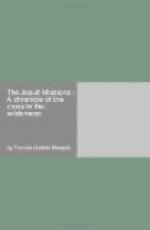Winter was the season of greatest trial. The cabins, crowded to suffocation, were made the scenes of savage mirth and feasting. The Hurons were inveterate gamblers; sometimes village would challenge village; and, as the game progressed, night would be made hideous with the beating of drums and the hilarious shouts of the spectators. Feasts were frequent, since any occasion afforded an excuse for one, and all feasts were accompanied by gluttony and uproar. The Dream Feast was a maniacal performance. It was agreed upon in a solemn council of the chiefs and was made the occasion of great licence. The guests would rush about the village feigning madness, scattering fire-brands, shouting, leaping, smiting with impunity any they encountered. Each one would seek some object which he pretended to have learned about in a dream. Only when this object was found would calmness follow; if it was not found, there would be deepest despair. Feasts, too, were prescribed by the medicine-men as cures for sickness; the healthy, not the sick, would take the medicine, and would take it till they were gorged. To leave a scrap of food on their platters might mean the death of the patient.
Only one of the social customs of the Hurons had any real religious significance. Every ten or twelve years the great Feast of the Dead took place. It was the custom of the Hurons either to place the dead in the earth, covering them with rude huts, or, more commonly, on elevated platforms. The bodies rested till the allotted time for final interment came round. Then at some central point an immense pit would be dug as a common grave. In 1636 a Feast of the Dead was held at Ossossane. To this place, from the various villages of the Bear clan, Indians came trooping, wailing mournful funeral songs as they bore the recently dead on litters, or the carefully prepared bones of their departed relatives in parcels slung over their shoulders. All converged on the village of Ossossane, where a pit ten feet deep by thirty feet wide had been dug. There on scaffolds about the pit they placed the bodies and bones, carefully wrapped in furs and covered with bark. The assembled mourners then gave themselves up to feasting and games, as a prelude to the final act of this drama of death. They lined the pit with costly furs and in the centre placed kettles, household goods, and weapons for the chase, all these, like the bodies and bones, supposed to be indwelt by spirits. They laid the dead bodies in rows on the floor of the pit, and threw the bundles of bones to Indians stationed within, who arranged the remains in their proper places.




